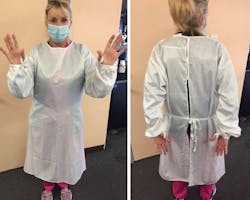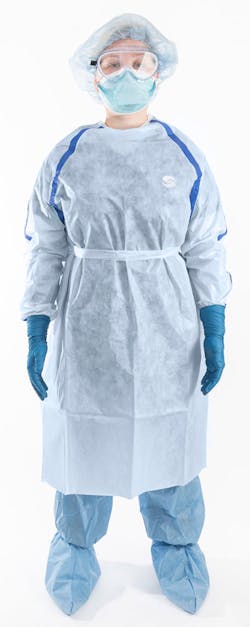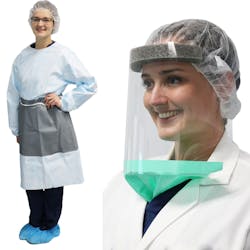PPE, top to bottom
In late March, 2020, the Association for Professionals in Infection Control and Epidemiology (APIC) set out to provide a picture of how supplies of personal protective equipment (PPE) were meeting demand in the nation’s hospitals. To that end, they conducted a survey.
Though the onslaught of SARS-CoV-2 cases was barely underway in the U.S., infection prevention specialists reported that their facilities were battling dire shortages.
“Nearly half of U.S. healthcare facilities surveyed are already out of, or almost out of respirators to use in caring for a patient with COVID-19,” reads an APIC March 27 press release. “Lack of N-95s, masks, face shields threaten health workers in facilities in every state, in every size facility.”
Pleas went out for Emergency Use Authorizations to be granted for use of non-traditional PPE sources, and for the reuse of masks and other PPE.
“Like so many companies, we struggled to get product from previously reliable suppliers,” said Ralph J. Basile, Vice President of Marketing for Healthmark Industries Company Inc. “Where we could, we altered our supply chain, including utilizing domestic sources of product – and we began manufacturing more in-house in order to better control supply and meet the increase in demand.”
Healthmark wasn’t the only company struggling to keep up.
“During COVID-19, the PPE industry has faced unprecedented surges in demand, port delays, raw material shortages, capacity constraints, labor shortages and manufacturing shutdowns,” said Asilinn La Brie, RN, BSN, MBA, Senior Consultant in Business and Clinical Optimization at Cardinal Health.
Cardinal had to remain flexible in its supply chain and sourcing approach, La Brie said, “but we were committed to only sourcing direct from reputable manufacturers and our own manufacturing network.”
Heather Mallinckrodt, Associate Vice President of Contract and Program Services at Vizient said the shortage was an equal-opportunity challenge.
“The magnitude of the pandemic – I don’t think anyone was fully prepared for that,” she said “The entire U.S. was struggling to get product.”
Unprecedented times, however, “require unprecedented speed and results.” The company demonstrated an ability to respond rapidly to provider needs, Mallinckrodt said.
“The broken supply chain is our most frustrating challenge,” said Melanie Miller, Vice President and Chief Strategy Officer for Silver Lining Apparel, which makes reusable isolation gowns. But, she said, “we became nimble and flexible and learned along the way to ensure that our product met care practice needs and exceeded expectations.”
As the even-more virulent Delta variant surged and eventually waned, many on the front lines of the pandemic have been able to imagine light at the end of the tunnel. But work at the companies that make, sell, buy and deliver infection protection products is only beginning. Strategic plans designed today, after all, may be heading into against a dramatically changed supply chain landscape.
In the meantime, executives say, they must prepare for the next supply chain curveball.
Adjusting one’s stance
When reflecting on 20 -plus months of supply uncertainty – and lessons to take away moving forward – the themes expressed across the industry are similar: More diversity must be built into a company’s lineup of PPE manufacturers, with an emphasis on production closer to home; More visibility and transparency must be built into the system so that clients and other stakeholders can track product and share information. And in order to be successful in the supply chain of tomorrow, a company will need to maintain flexibility and be able to shift gears quickly.
Domestic production, said Anika Sutter, a Vizient Portfolio Executive, “has become more of a focus. Members are interested in being more localized,” she said. Expectations have grown, she said, for more specific product information, Sutter said. For instance, they are more concerned than ever about each product’s pedigree – where the components were sourced.
When the first wave of COVID-19 started its assault on the U.S. healthcare system, elective surgeries nearly everywhere were put on hold. Demand for surgery-related products was put on hold too, said Lionel Bonte, Vice President of Medical Business, Ahlstrom-Munksjo.
Leadership at the Finnish company moved its focus away from the sterilization wraps that had been a reliable part of their lineup, and doubled down on production of PPE items most needed during the pandemic.
“As a result of the material scarcity driven by the shortage, our mix (of products) has shifted toward higher demand in the face mask and the drapes and gowns category,” Bonte said.
“We went to great lengths of operational agility to increase capacity, restart dormant assets and restaff existing assets,” he said. “ We were also very successful in adapting our portfolio to meet the growing demand of face mask and isolation gowns by developing and validating new products.”
War room
One of Vizient’s first moves in response to COVID-19 and supply chain concerns was to open channels of communication between manufacturers, suppliers and end users.
“As shortages grew, we had to ensure provider needs were met,” said Mallinckrodt. “We set up what we call ‘the War Room’ to field provider questions, validate new products and provide near real-time information to members as well as clinical support in cross-referencing and substitutions during the shortfall.”
Mallinckrodt said Vizient already had been working to create a system of transparency, and to develop a broader network of suppliers.
“COVID pushed those initiatives forward faster,” she said.
Allison Pearsall, Honeywell Senior Product Management Leader, Healthcare PPE, said her company also wasted no time making adjustments.
“Honeywell quickly invested in the rapid addition of multiple production lines in the U.S. and North America to produce NIOSH (National Institute for Occupational Safety & Health) -approved N95 respirators and surgical N95 respirators to help fill the significant gap in the market supply,” she said. “Honeywell is now one of the leading brands of N95s for the healthcare segment.”
“We were pursuing moving production of key items of our infection control apparel and facial protection portfolios,” La Brie said. “The pandemic underscored this need for a strict quality control process and resilient supply chain in North America.”
Today, the company is launching more than 20 new PPE items, La Brie said, “all manufactured in North America.”
New approaches, new products
Tai Edmund, Vice President Healthcare, Tronex International, said his company, which supplies disposable isolation and protective gowns, exam-grade gloves and face masks, managed to weather the storm by diversifying locations for manufacturing.
“Tronex Healthcare’s longstanding supply resiliency strategy of optimizing production diversification, maintaining deep and continually expanding manufacturing capacity and capabilities, and maintaining US-based program supply buffers across multiple national warehouses,” Edmund said, “proved essential to assuring our program (provides) customers robust supply.”
In addition to new lines of PPE products and new services -- introduced during some very difficult months of the pandemic -- a new team at a familiar B2B company made its debut.
Alibaba.com Select uses the Chinese company’s global online marketplace model to source PPE and get those products to where they’re most needed.
“We are seeing that there are issues across many product categories,” said Josh Price, Head of Strategy & Operations at Alibaba.com Select, North America. “Businesses face challenges identifying supply, shipping their orders due to container shortages, gaining access to vessel space and port shutdowns and congestion.”
Alibaba.com’s U.S.- based team, “facilitates global B2B ecommerce trade at scale,” Price said.
“We work with a network of suppliers that offers a variety of products, including surgical masks, isolation gowns, face shields, goggles, nitrile gloves, vinyl gloves and much more,” Price said. The company, “has the supply chain insights and capabilities to assist customers with getting their orders to where they need them by connecting with a variety of qualified logistics services.”
At the height of the pandemic, Healthmark industries added two new products to its portfolio of PPE accessories. Both products are designed to be worn in decontamination areas.
The wrap-around decontamination gown, designed for use in device reprocessing areas, eliminates the need for a plastic apron, according to a website description.
It features a middle section, “manufactured of a liquid impervious zone, including preventing strikethrough of detergent cleaning solutions even when physically leaning against sinks or other cleaning baths.”
Healthmark’s face shield with drape is meant to be worn, “where added protection from splashing is recommended.”
The drape, according to the description, “adds a 12-inch fluid barrier that extends below the standard face shield and tucks inside a protective garment, providing additional protection in the area under the shield from splashing.”
Honeywell also added to its product line during the COVID-19 pandemic.
The new Soft Comfort Nitrile Exam Glove, is designed, Pearsall said, “for low-fluid exposure situations.”
The gloves offer “easy donning and high tactile sensitivity,” she said, and represent the newest option among the company’s portfolio of exam gloves.
Bonte said that Ahlstrom-Munksjo has seen demand for masks -- both medical and civilian grow at an unprecedented pace.since the start of the pandemic.
In response, “the company decided to use its sustainable product offering and momentum to develop its face mask materials further,” Bonte said. Ahlstrom-Munksjo’s new TenderGuard product portfolio, “offers a full suite of fabrics for medical and civil use face masks.”
“The product is biodegradale and compostable under controlled conditions (by European standards),” bonte said. The masks, “are protective, hypoallergenic and environmentally friendly.”
“As the latest wave of COVID-19 recedes, cancer patients have started returning to chemo treatment centers, and physical protection for staff at those facilities is as important as ever.
The Cardinal Health ChemoPlus gowns and sleeves, produced in North America, limit exposure risks for those who handle chemotherapy drugs. The new, comprehensive PPE line, according to a company description, “provide AAMI Level3 fluid protection, are USP-800 compliant, and are tested for use with 16 types of chemotherapy drugs, from preparation and handling to administration and disposal.”
Building reassurance
In the summer of 2020, just a few months after the first wave of COVID-19 had peaked, Vizient embarked on a new series of expansion partnerships.
An agreement with Encompass Group LLC in August 2020 provides access to a much greater supply of PPE. It also allows Encompass to begin manufacturing in the U.S., which it will likely do in early 2022. The company currently uses manufacturing lines created in Mexico with Vizient.
The move, according to a press release from August, 2020, “is part of Vizient’s larger strategy to outmaneuver uncertainty by creating a more resilient supply chain built on transparency and trust between manufacturers and providers.”
The strategy, “includes increased visibility of raw materials and product origin, expanded domestic capacity and additional onshore inventory for member hospitals,” according to the Vizient press release.
And Vizient isn’t the only organization looking for new partnerships in the wake of COVID-19.
Honeywell recently announced a collaboration with Premier Inc. to expand U.S. production of nitrile exam gloves and increase the domestic production capacity for those products.
The themes are increasingly familiar: More transparency is necessary throughout the industry. Resilience and flexibility must be baked in. And eggs should not all be placed in one basket.
“The manufacturing competitive landscape will become a lot more aggressive than it has ever been,” Bonte of Ahlstrom-Munksjo predicts. “The traditional manufacturer landscape might look differently in two years from now, only making room for the most agile.”



